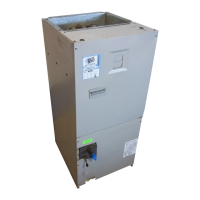G6RA, G6RK Service Manual 9
Figure 1. G6RA Horizontal Installation
Suspended in Attic or Crawl Space
Combustion air must not be drawn from a
corrosive atmosphere.
CAUTION:
!
WARNING:
Furnace installation using methods other
than those described in the following
sections must comply with the National Fuel
Gas Code and all applicable local codes to
provide sufficient combustion air for the
furnace.
!
VENTING AND COMBUSTION
AIR REQUIREMENTS
General
Provisions must be made in the installation of this furnace to
provide an adequate supply of air for combustion. Detailed
instructions for determining the adequacy of an installation
can be found in the current revision of the National Fuel Gas
Code (ANSI Z223.1 / NFPA54) or in applicable local building
codes. Consult local codes for special requirements. For
Canadian installations consult Canadian Installations Codes
and (CAN/CGA B149.1 or .2).
If the furnace is operated with inadequate air for combustion
one of the flame roll-out switches located in the burner
compartment or the vent switch will open, turning off the gas
supply to the burners. These safety devices are manually
reset switches. DO NOT install jumper wires across these
switches to defeat their function. DO NOT reset a switch
without identifying and correcting the fault condition. If a
switch must be replaced, use only the correct part specified
in the Replacement Parts List.
Air openings in the furnace door, warm air registers, and
return air grilles must not be restricted.
To maximize heat exchanger life, the combustion air must be
free of chemicals which form corrosive acidic compounds in
the combustion gases. Some examples of these chemicals
are chlorine, fluorine, and sulphur. Some common sources
of these chemicals are detergents, bleaches, aerosol sprays,
cleaning solvents, and a wide variety of commercial and
household products.
When installing a furnace in a commercial building or in a
laundry room or workshop of a residence, it may be necessary
to provide outside air to the furnace for combustion.
Installation In An Unconfined Space
An unconfined space is an area including all rooms not
separated by doors with a volume greater than 50 cubic feet
per 1,000 Btuh of the combined input rates of all appliances
which draw combustion air from that space.
For example, a space including a water heater rated at 45,000
Btuh input and a furnace rated at 75,000 Btuh requires a
volume of 6,000 cubic feet [50 x (45 + 75) = 6,000] to be
considered unconfined. If the space has an 8 foot ceiling, the
floor area of the space must be 750 square feet (6,000 / 8 =
750). In general, a furnace installed in an unconfined space
will not require outside air for combustion. However, in “tight”
buildings (with weather stripping and caulk to reduce infiltration),
it may be necessary to provide outside air to ensure adequate
combustion and venting, even though the furnace is located
in an unconfined space.
Installation In A Confined Space
A confined space is an area with volume less than 50 cubic
feet per 1,000 Btuh of the combined input rates of all
appliances drawing combustion air from that space. Furnace
closets, small equipment rooms and garages are confined
spaces. Furnaces installed in a confined space which supply
heated air to areas outside the space must draw return air
from outside the space and must have the return air ducts
tightly sealed to the furnace. A confined space must have
two openings into the space for combustion air. One
opening must be within 12 inches of the ceiling, and the
other must be within 12 inches of the floor. The required
sizing of these openings is determined by whether inside or
outside air is used to support combustion, the method by
which the air is brought to the space, and by the total input
rate of all appliances in the space.
Horizontal Furnace Installation
The G6RA can be installed horizontally in an attic, basement,
crawl space or alcove. It can be suspended from a ceiling in
a basement or utility room in either a right to left airflow or left
to right airflow. (See Figures 1 and 2.)

